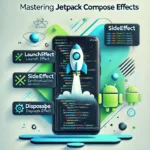Hey fellow Android developers! After spending countless hours in the trenches with Jetpack Compose and mentoring teams through their transition from XML layouts, I’ve put together everything I know about handling effects in Jetpack Compose. Grab your favorite coffee, and let’s dive deep into this!
Why We Need Effects (And Why They’re Often Misunderstood)
Let me start with a story from last week. I was reviewing a junior developer’s code, and I saw something like this:
@Composable
fun UserDashboard() {
var userData by remember { mutableStateOf<UserData?>(null) }
// DON'T do this!
val scope = rememberCoroutineScope()
scope.launch {
userData = repository.fetchUserData()
}
}Seems innocent enough, right? Wrong! This launches a new coroutine on every recomposition. This is exactly why we need effects – to handle these side operations properly.
The Complete Effects Family

Let’s break down each type of effect and when to use them:
1. LaunchEffect: Your Workhorse
Think of LaunchEffect as your reliable colleague who handles all the heavy lifting. Here’s a real production example:
@Composable
fun PaymentScreen(
orderId: String,
viewModel: PaymentViewModel
) {
var paymentStatus by remember { mutableStateOf<PaymentStatus?>(null) }
var transactionError by remember { mutableStateOf<String?>(null) }
LaunchEffect(orderId) {
try {
// Process payment and handle status updates
viewModel.processPayment(orderId)
.collect { status ->
paymentStatus = status
when (status) {
is PaymentStatus.Success -> {
// Handle success
}
is PaymentStatus.Failed -> {
transactionError = status.errorMessage
}
}
}
} catch (e: Exception) {
transactionError = "Payment processing failed: ${e.localizedMessage}"
}
}
// UI implementation
}2. SideEffect: The Quick Helper
SideEffect is perfect for those “fire and forget” operations. Here’s how I use it in production:
@Composable
fun FeatureScreen(
screenName: String,
userData: UserData
) {
// Analytics tracking
SideEffect {
analytics.logScreenView(
screenName = screenName,
userType = userData.type,
timestamp = System.currentTimeMillis()
)
}
}3. DisposableEffect: The Cleanup Crew
Here’s a real-world example of handling WebSocket connections:
@Composable
fun LiveDataFeed(socketUrl: String) {
var messages by remember { mutableStateOf<List<Message>>(emptyList()) }
DisposableEffect(socketUrl) {
val webSocket = WebSocket(socketUrl)
webSocket.connect()
webSocket.onMessage { message ->
messages = messages + message
}
onDispose {
webSocket.disconnect()
// Cleanup any resources
}
}
}Real-World Patterns and Solutions
Pattern 1: The Loading-Content-Error Pattern
Here’s a pattern I use in almost every project:
@Composable
fun <T> ContentLoader(
loadingContent: @Composable () -> Unit = { LoadingSpinner() },
errorContent: @Composable (String) -> Unit = { error -> ErrorMessage(error) },
content: @Composable (T) -> Unit,
loader: suspend () -> T
) {
var data by remember { mutableStateOf<T?>(null) }
var error by remember { mutableStateOf<String?>(null) }
var isLoading by remember { mutableStateOf(true) }
LaunchEffect(Unit) {
try {
isLoading = true
data = loader()
} catch (e: Exception) {
error = e.message
} finally {
isLoading = false
}
}
when {
isLoading -> loadingContent()
error != null -> errorContent(error!!)
data != null -> content(data!!)
}
}Usage:
ContentLoader(
loader = { repository.fetchUserData() }
) { userData ->
UserProfile(userData)
}Pattern 2: Infinite Scroll with Effects
Here’s how I implement infinite scrolling:
@Composable
fun InfiniteScrollList(
items: List<Item>,
onLoadMore: suspend () -> Unit
) {
var isLoadingMore by remember { mutableStateOf(false) }
var loadError by remember { mutableStateOf<String?>(null) }
LazyColumn {
items(items) { item ->
ItemRow(item)
}
item {
if (isLoadingMore) {
LoadingRow()
}
if (loadError != null) {
ErrorRow(loadError!!) {
// Retry logic
}
}
}
// Pagination trigger
LaunchEffect(items.size) {
if (!isLoadingMore && loadError == null) {
try {
isLoadingMore = true
onLoadMore()
} catch (e: Exception) {
loadError = e.message
} finally {
isLoadingMore = false
}
}
}
}
}Pattern 3: State Management with Effects
Here’s a pattern for managing complex state transitions:
@Composable
fun StateManager<T>(
initialState: T,
transitions: List<StateTransition<T>>
) {
var currentState by remember { mutableStateOf(initialState) }
LaunchEffect(currentState) {
transitions
.filter { it.fromState == currentState }
.forEach { transition ->
try {
val newState = transition.execute()
currentState = newState
} catch (e: Exception) {
// Handle transition errors
}
}
}
}
data class StateTransition<T>(
val fromState: T,
val execute: suspend () -> T
)Performance Optimization Tips
1. Effect Scoping
@Composable
fun OptimizedComponent() {
// Bad - creates new function on every recomposition
LaunchEffect(Unit) {
val result = withContext(Dispatchers.IO) {
// Heavy operation
}
}
// Good - stable function reference
val heavyOperation = remember {
suspend {
withContext(Dispatchers.IO) {
// Heavy operation
}
}
}
LaunchEffect(Unit) {
heavyOperation()
}
}2. Key Selection
Here’s a comparison of different key strategies:
| Key Type | When to Use | Impact |
|---|---|---|
| Unit | One-time effects | Runs once per composition |
| Single value | Track specific value | Reruns when value changes |
| Multiple values | Track multiple dependencies | Reruns when any value changes |
3. Error Handling Patterns
Here’s my production-ready error handling pattern:
sealed class EffectResult<out T> {
data class Success<T>(val data: T) : EffectResult<T>()
data class Error(val exception: Exception) : EffectResult<Nothing>()
}
@Composable
fun <T> SafeEffect(
key: Any,
operation: suspend () -> T,
onResult: (EffectResult<T>) -> Unit
) {
LaunchEffect(key) {
try {
val result = operation()
onResult(EffectResult.Success(result))
} catch (e: Exception) {
onResult(EffectResult.Error(e))
}
}
}Testing Effects
Here’s how I approach testing effects:
@Test
fun `test loading state and success`() = runTest {
val testViewModel = TestViewModel()
composeTestRule.setContent {
var result by remember { mutableStateOf<String?>(null) }
LaunchEffect(Unit) {
result = testViewModel.loadData()
}
when (result) {
null -> Text("Loading")
else -> Text(result!!)
}
}
// Verify loading state
composeTestRule.onNodeWithText("Loading").assertExists()
// Wait for data
composeTestRule.waitUntil(timeoutMillis = 5000) {
composeTestRule.onNodeWithText("Test Data").exists()
}
}Common Pitfalls and Solutions
1. Memory Leaks
@Composable
fun LeakFreeComponent(viewModel: MyViewModel) {
// Bad - potential memory leak
val context = LocalContext.current
LaunchEffect(Unit) {
viewModel.someFlow
.onEach {
// Using context here can cause leaks
Toast.makeText(context, "Update", Toast.LENGTH_SHORT).show()
}
.collect()
}
// Good - using remember for context operations
val showToast = remember(context) { { message: String ->
Toast.makeText(context, message, Toast.LENGTH_SHORT).show()
} }
LaunchEffect(Unit) {
viewModel.someFlow
.onEach { showToast("Update") }
.collect()
}
}2. Race Conditions
@Composable
fun RaceConditionFree(viewModel: MyViewModel) {
var data by remember { mutableStateOf<String?>(null) }
// Bad - potential race condition
LaunchEffect(Unit) {
viewModel.loadData().collect { newData ->
data = newData
}
}
// Good - using collectLatest
LaunchEffect(Unit) {
viewModel.loadData().collectLatest { newData ->
data = newData
}
}
}Wrapping Up
Effects in Jetpack Compose are powerful tools when used correctly. Remember:
- Use LaunchEffect for coroutine operations
- Use SideEffect for synchronization
- Use DisposableEffect for cleanup
- Always handle errors and edge cases
- Test thoroughly
- Watch out for memory leaks
- Choose appropriate keys
Common Questions & Answers About Effects in Jetpack Compose
Q: When should I use LaunchEffect vs SideEffect?
A: Use LaunchEffect for coroutine operations like API calls or long-running tasks. Use SideEffect for synchronizing with non-Compose code, like analytics tracking. LaunchEffect is scoped to composition lifecycle, while SideEffect runs after every successful composition.
Q: How do I prevent my effect from running multiple times?
A: Use proper keys in LaunchEffect:
// Runs on every recomposition - BAD
LaunchEffect(System.currentTimeMillis()) { ... }
// Runs only when userId changes - GOOD
LaunchEffect(userId) { ... }
// Runs once - GOOD
LaunchEffect(Unit) { ... }Q: How do I handle cleanup in effects?
A: Use DisposableEffect for cleanup operations:
DisposableEffect(key1) {
// Setup code
onDispose {
// Cleanup code
}
}Q: How do I test effects?
A: Use TestRule and waitUntil:
@Test
fun testEffect() = runTest {
composeTestRule.setContent {
EffectComponent()
}
composeTestRule.waitUntil(5000) {
// Assert conditions
}
}Q: Can I collect flows in effects?
A: Yes, but use collectAsState when possible:
// Preferred way
val state by flow.collectAsState(initial = null)
// Use LaunchEffect for complex flow handling
LaunchEffect(Unit) {
flow.collectLatest { ... }
}Q: How do I handle errors in effects?
A: Always wrap effect content in try-catch:
LaunchEffect(Unit) {
try {
// Effect operation
} catch (e: Exception) {
// Error handling
}
}Q: Can I use multiple effects in one composable?
A: Yes, but consider combining related effects:
// Better approach
LaunchEffect(Unit) {
launch { effect1() }
launch { effect2() }
}Q: How do I update state from effects?
A: Use mutableStateOf and remember:
var state by remember { mutableStateOf(initial) }
LaunchEffect(Unit) {
state = newValue
}Q: How do I prevent memory leaks in effects?
A: Always use remember for context operations and clean up resources:
val context = LocalContext.current
val showToast = remember(context) { { message: String ->
Toast.makeText(context, message, Toast.LENGTH_SHORT).show()
} }Q: What’s the best practice for handling configuration changes?
A: Use rememberUpdatedState for latest values:
val latestCallback = rememberUpdatedState(callback)
LaunchEffect(Unit) {
latestCallback.value()
}Final Thoughts
Effects in Jetpack Compose are powerful tools that need careful handling. Remember these key points:
- Always handle errors
- Use appropriate effect types
- Clean up resources
- Test thoroughly
- Choose proper keys
- Consider performance implications
The best way to master effects is through practice and real-world implementation. Start with simple use cases and gradually move to more complex scenarios.
Need more help? Check out:
- Official Compose Documentation
- Compose Samples Repository
- Android Dev Forums
Stay curious and keep experimenting! The best way to learn is by doing.
Got questions? Drop them in the comments below! I’d love to hear about your experiences with effects in Compose.



